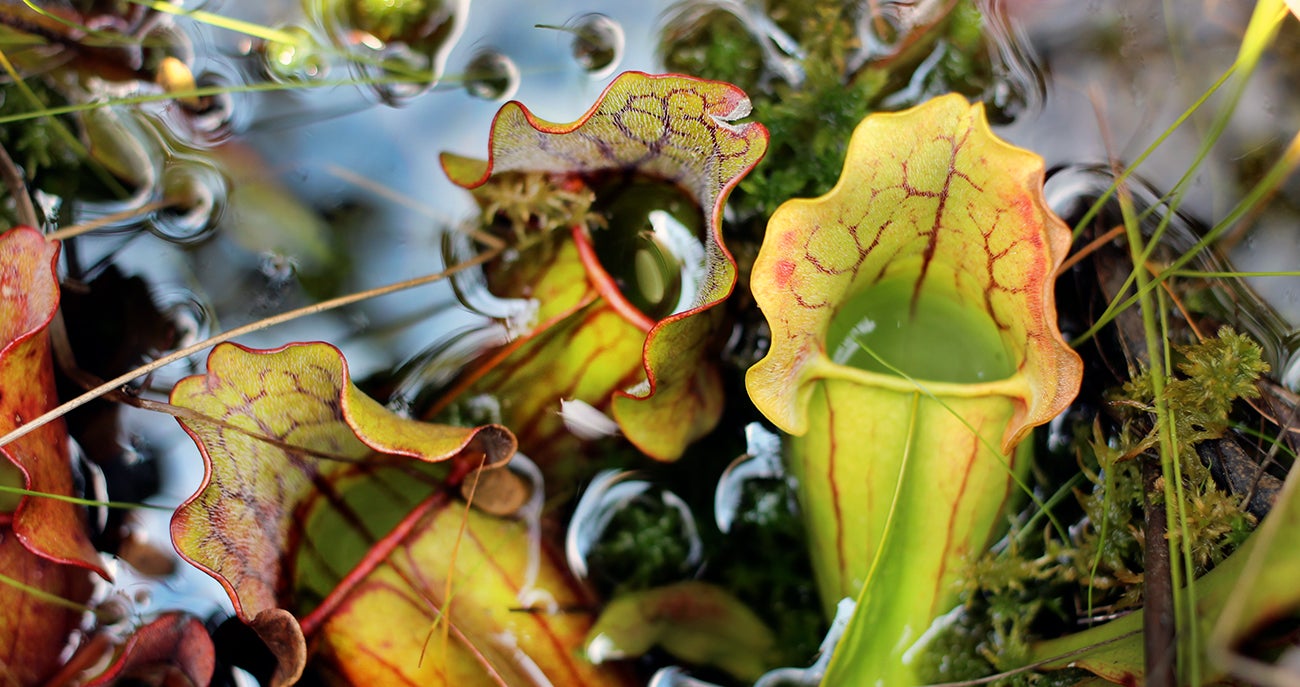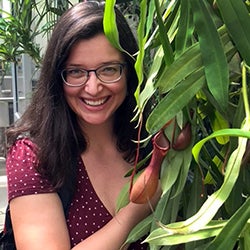
The carnivorous pitcher plant has colorful, usually variegated, leaves shaped like little cups. Water collects inside the pitcher plant where it digests insects that are attracted to the nectar on its slippery leaves and then fall into the water. Carnivorous pitcher plants live along the east and west coasts of the United States, South America, Southeast Asia and even Australia. These plants live in low-nutrient soils, often bogs, and survive by “eating” insects.
Leonora Bittleston, an assistant professor of biology at Boise State, doesn’t study the carnivorous pitcher plant or even the insects it eats. She studies something smaller within the water that collects inside its cup-like leaves. Specifically, Bittleston studies how the microbial communities within the water of these host plants form and how they are similar or different across very distantly related carnivorous pitcher plants. Scientists call this process, when distinctly different organisms develop similar traits to survive, convergent evolution. Bittleston described that, “We have this convergent evolution of the plant host and then we can look at how the microbial communities are similar or different across these separate evolutionary events.” Understanding how a similar host environment can shape a microbiome can have implications beyond pitcher plants, to other ecosystems or even the microbes living in our own bodies.
The Simons Foundation recently presented Bittleston the Simons Early Career Investigator in Aquatic Microbial Ecology and Evolution Award to continue her research into the microbial systems within these plants. “I think part of why they’re interested in my research is that I’m using a model system to be able to understand how microbial communities assemble,” she said. Bittleston will be using the award to investigate coexistence in microbial communities, and how we can build more complex microbiomes that better mimic those of natural systems. The foundation’s website states that, “the purpose of these awards is to help launch the careers of outstanding investigators in the fields of microbial ecology and evolution in marine or natural freshwater systems, who will advance our understanding through experiments, modeling or theory.”

She started thinking about that model system while working on her doctoral degree, when she discovered that convergently evolved hosts shape similar microbiomes. Afterwards, as a postdoctoral fellow, Bittleston “wanted to create a lab tractable system”—a controlled space where she can more easily study the communities of microbes. And she has continued that in her lab at Boise State, where she grows the microbial communities in little tubes that replicate their natural environment or in pitcher plants living in programmable growth chambers. Although, instead of waiting for insects to fall into the plants, she feeds them ground cricket powder that she purchases online. She described how she “became more interested in thinking about what controls how these communities assemble” when completing her doctoral degree. Her research asks questions like, how do species interactions in these little communities affect their stability? What functional traits do they have? Do they break down chitin, one of the main biopolymers in the insect exoskeleton, to make more nutrients available to the plant for growth? And ultimately, how do these microbes evolve in a community context?
One of only four recipients, the award provides Bittleston $810,000 over three years beginning in April 2023 to support her research by providing funding for travel, equipment and supplies in addition to funding partial salaries for herself, post doctoral and graduate research assistants. Unlike some awards that support specific research projects, the Simons Foundation award allows Bittleston and her team to follow the research as much as it pertains to aquatic microbial systems. “I’m really excited that it gives freedom to the lab and to the research,” she said. “It’s amazing when you get a grant that provides general support and that allows for creativity and exploration.”
Bittleston also mentioned how the support of the Department of Biological Sciences at Boise State makes it possible to share this research not only with graduate students, but also with undergraduate students who may not otherwise have the opportunity to be involved with active research. “I like that within the department there is space to integrate research and teaching and to have different approaches and different focus and have that flexibility.”
“Microbes really drive life on Earth,” Bittleston said. “A lot of the nutrient and energy cycling that happens in our ecosystems is driven by microbes. They are so tiny, but they have these huge outsize effects on ecosystems and all the different organisms that they associate with.”
Discover more about Bittleston’s work and her lab at www.bittlestonlab.com.
This work is supported by a grant from the Simons Foundation (3857009, LB) Award ID: LS-ECIAMEE-00001638.